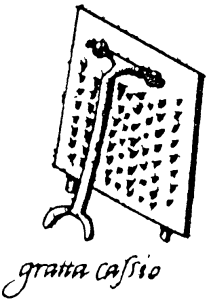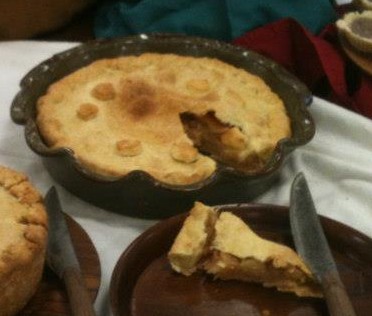What, Where, When:
What, Where and When:
- My interpretation of a bread tart is a dish somewhere between custard and bread pudding, baked in a pie shell.
- The original recipe is by Sabina Welserin, who wrote her cookbook in 1553, in what is now Germany.
Original Recipes from Sabina Welserin:
136 A bread tart Take white bread and grate it, take cream, stir it together,so that it becomes thick like a pudding. Take six egg yolks, beat them well and with spices thereon, put everything together in a pastry shell, and bake it like other tarts.
61 To make a pastry dough for all shaped pies
Take flour, the best that you can get, about two handfuls,depending on how large or small you would have the pie. Put it on the table and with a knife stir in two eggs and a little salt. Put water in a small pan and a piece of fat the size of two good eggs, let it all dissolve together and boil. Afterwards pour it on the flour on the table and make a strong dough and work it well, however you feel is right. If it is summer, one must take meat broth instead of water and in the place of the fat the skimmings from the broth. When the dough is kneaded, then make of it a round ball and draw it out well on the sides with the fingers or with a rolling pin, so that in the middle a raised area remains, then let it chill in the cold. Afterwards shape the dough as I have pointed out to you. Also reserve dough for the cover and roll it out into a cover and take water and spread it over the top of the cover and the top of the formed pastry shell and join it together well with the fingers. Leave a small hole. And see that it is pressed together well, so that it does not come open. Blow in the small hole which you have left, then the cover will lift itself up. Then quickly press the hole closed. Afterwards put it in the oven. Sprinkle flour in the dish beforehand. Take care that the oven is properly heated, then it will be a pretty pastry. The dough for all shaped pastries is made in this manner.
Discussion:
I chose this particular recipe because it was a somewhat unusual dessert, but sounded as though it would be pleasant to modern sensibilities. I’ve also mostly cooked from earlier, French cookbooks, so I thought late period German would be an interesting area to branch into.
The first question to be answered about the filling was what the author intended the texture of the pie to be. Depending on the ratio of cream to eggs to bread, and the consistency of the grated bread, the pie could be anywhere from a slightly thickened custard to a “bread pudding” like this. I chose to avoid either of the two extremes and create a dish that was somewhere in the middle.
Once this decision was made, I experimented with the ratios of cream to eggs to bread to reach the final redaction. During this process, I found that the order in which the ingredients are combined is important – bread crumbs should be added to liquid, to prevent “clumping” of the breadcrumbs. Unfortunately, the only way I found to remove all lumps in the filling was to use a modern blender, which I chose not to do for this redaction.

Another important point is the type of bread crumb used. Sabina Welserin specified “grated” bread , which was probably grated on a metal grater. Fresh bread does not grate well (it shreds) so I let a commercial sourdough loaf (made with no preservatives) air dry for a few days, then grated it on a metal grater – a similar grater from 16th century Italy is shown in the image to the right. This produced a much “fluffier” breadcrumb than commercial dried bread crumbs, which seemed to dissolve in the cream better as well. Unfortunately, I ran out of the grated breadcrumbs and had to add a small amount of commercial crumbs, however, I do feel that the texture of the pie was improved by using as much grated bread as possible.
Welserin does not specify the type of spicing used. Therefore, I chose to use a spice mixture I had on hand, created from instructions in an earlier source, Le Menagier de Paris. I enjoy this particular blend of spices, and thought it would accent the bread/custard nicely. I also added sugar, as this would also fall under “spices” in a medieval kitchen and I wanted the dish to be appealing to modern tastes as a “dessert”.
The crust was interesting – the instructions in the original are for a “shaped pie”, and so the crust is stronger and therefore tougher than a modern pie crust. I did find the crust to be much easier to roll out than a modern crust, however, and the butter and eggs make it rich and tasty. Sabina Welserin’s handfuls must have been much larger than mine, however, for I only needed to use half of the butter/water mixture. Another note on the butter – 1 stick of butter is approximately equal in size to 2 large eggs. Lard may have been more plausibly used by Welserin, but it wasn’t available to me.
The original pie would have been baked in a wood-fired oven, or in a fireplace, probably in a clay pie pan. I do not have a fireplace or wood oven; however I did cook the pie in a clay pie pan.
A Bread Tart
Ingredients
- Crust
1.5 Cups Unbleached flour
2 eggs
1 stick of butter
water
- Filling
3 cups cream
Approximately 2 cups bread crumbs
6 egg yolks
3/4 cup sugar
2 tsp spice blend – clove, ginger, nutmeg, cinnamon, long pepper, cubeb, grains of paradise, mace
Directions
- To make crust
- Melt butter over low heat with a small amount (1/4 cup) of water.
- Mound flour on work surface, make well.
- Break eggs into well, cut into flour with knife.
- Once eggs have been evenly distributed throughout flour, form into mound with well again.
- Pour in a small amount of butter/water mixture, knead carefully. Continue adding liquid until dough reaches workable consistency.
- Knead until dough is stretchy and pliable.
- Roll out dough and place in pie pan.
- To make filling
- Place cream in bowl.
- Add breadcrumbs gradually, stirring constantly, until mixture reaches “thin pudding” stage – mixture will continue to thicken as cream is absorbed into breadcrumbs.
- Beat egg yolks with sugar and spices in separate bowl.
- Combine eggs with breadcrumb mixture, beat well and pour/spoon into prepared piecrust.
- Bake at 350 for approximately 45 minutes, or until filling is set and starting to brown..

3 Comments
This is brilliant. Very clearly explained and a good redacted recipe. I’d like to try this. It is always tricky trying to work out ratios on this type of filling. When I made a curd tart from a 14th-century English recipe, bread crumbs were specified. I held back and put in just a couple of tablespoons’ worth. It was lovely but I would like to see (taste!) what more bread would do to it. Thanks again fir a great post.